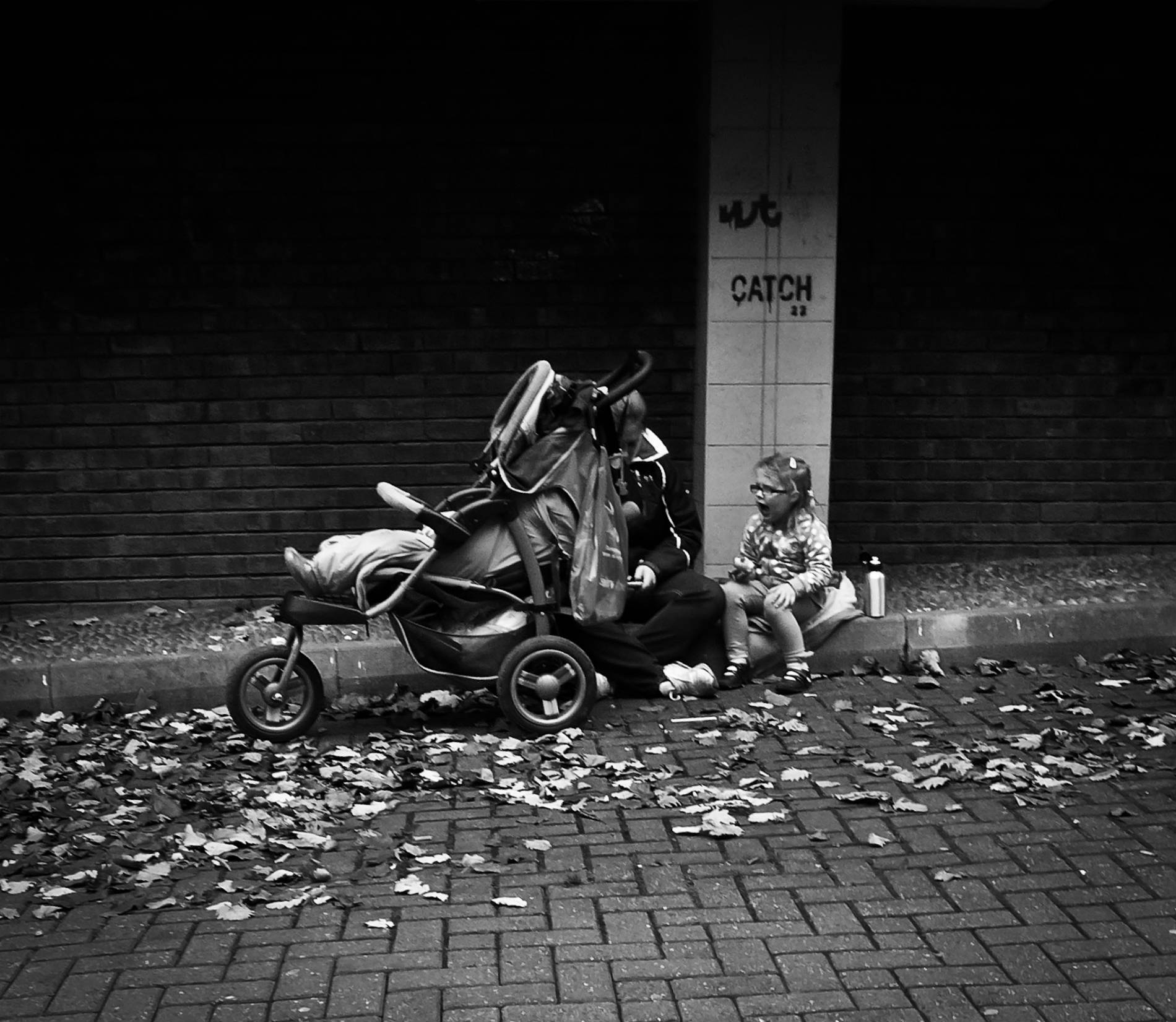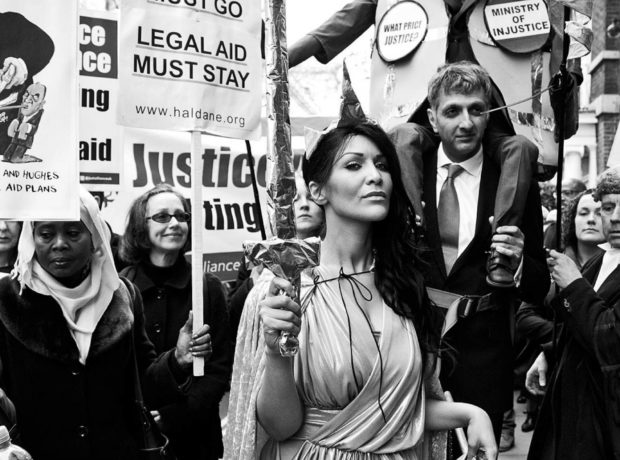Women are paying for austerity, and will continue to do so for years to come. The most recent research, from the House of Commons library, shows that around 80% of money raised from benefit and tax changes in the UK since 2010 come from women’s incomes. But the cuts are about more than money, public services and public sector jobs lost. What happens when the cuts clash with existing gender inequalities? If we take one particular cut, the slashing of the legal aid budget, it appears that the poorest women are being hurt in complex ways with great social repercussions. Lisa Muggeridge explains how.
As a woman, there are things you take for granted when you live in a country where equality laws were passed generations ago: the right to work, the right to autonomy over your relationships, the responsibility to protect yourself and your children from abuse. As the next general election approaches, reading the political press, you might assume that politicians want to build on these rights; and in particular, that domestic abuse is a shared ‘number one’ priority.
Yet these very same rights have been stripped away from those mothers lacking the shelter of a man’s income or family wealth, in ways that perpetuate existing gender and class inequalities.
all mothers – even victims of domestic abuse – must prevent their children from witnessing or being part of that domestic abuse or else face losing them
Let’s look a little closer at a woman’s responsibility to protect her children. Since 1989 the law has required parents to protect their children from harm, on the understanding that all parents in the UK had this ability and any failure on this front was their fault. The Children Act 1989 was later amended to classify witnessing domestic abuse as “significant harm” so that all mothers – even victims of domestic abuse – must prevent their children from witnessing or being part of that domestic abuse or else face losing them.
The ability of many working class mothers to meet this legal requirement was removed from 2010 onwards under the austerity-driven financialisation of our economy. A mother’s ability to survive without a partner’s income and participate in the labour market while caring for her children, once protected by welfare benefits and public services, was undermined with catastrophic consequences. Yvette Cooper, a senior Labour politician, commissioned research from the parliamentary library in 2010, which warned “equality would be rolled back” by austerity for working class women, and yet this shift has passed almost without discussion.

The Poverty Trap. Photo by Neil Moralee
The removal of almost all legal aid for family court proceedings has exposed a pre-existing crisis, some courtrooms routinely used to remove the ability of women to protect themselves and their children from abuse. I have watched women in family courts without legal representation effectively being put on trial by their abusers, with their kids at stake. Poverty created by austerity used as evidence of unfitness to parent. In some cases, child protection proceedings quickly escalate to adoption, because mothers failed to protect children from the abuse they themselves were also victims of. Children’s services departments seem only to have the resources to police families – in effect, mothers – while recent child abuse scandals show how vulnerable children become once they are removed. Those departments, like the services women need to free themselves from abuse, were slashed to breaking point post-election. Inequality is the watchword on the lips of economists and politicians, while mothers all over Britain wonder whether equality ever existed at all.
Welfare reforms, public service cuts, legal aid restrictions, a growing list of seemingly distinct social policy changes, together signal a frightening future for women and children trying to escape domestic abuse. The changes have upset the balance of family courtrooms so much that questions must be asked about whether the demands of the Children Act can be met, and whether women suffering the inequality motherhood creates – and the children they parent – can have their human rights upheld at all.
Inequality outside the courtroom, maternal poverty and domestic abuse
It is uncontroversial to say that women should be protected from abusive partners and that support ought to be easily available for domestic abuse victims. Politicians across the political spectrum regularly raise the issue, some have even learnt the stats by heart; two women a week die at the hands of partners or former partners, they tell us. Meanwhile last year the Home Office revised its definition of domestic abuse to include non-violent but coercive behaviour.
Still, there exists among legislators a curious inability to join the dots. Yes, identify the problem, but let’s also think about the social and economic inequalities that make it worse, and in many cases create the conditions where abuse is more likely to occur.
Take non-violent coercion in abusive relationships. That financial control is central to coercion is recognised, but thinking stops there, and no mention is made of the economic inequality that motherhood creates by reducing participation in the labour market and thus forcing dependence on a partner’s income. Once mothers leave abusive situations, their new status as ‘single’ parents makes them easy scapegoats for all political parties. On the one hand politicians say they want to support women to leave abusive relationships, on the other hand, the life of a single parent is made economically difficult and publicly vilified by politicians in speeches and in policies like the housing benefit cap, which hurt single mothers the most.
The Fawcett Society and other civil society organisations repeatedly publish research into the gendered impact of austerity, and this work is routinely ignored. Before the press began covering the issue of food poverty, it was already being reported that one in five mothers in Britain was missing meals, a clear sign of their diminished ability to provide for their children as required by the Children Act.
Under the current Department for Work and Pensions policies “unemployed” mothers of children over five must submit to a punitive Jobseeker’s Allowance conditionality regime that makes a consistent income near impossible and demands control of all their time, including the time that would be spent caring for their children. The tax-credits system creates debts through overpayments which can drain incomes for years. The two main parties appear committed to extending conditionality – currently confined to Jobseeker’s Allowance – to the welfare-dependent working population, including most of these mothers. This war on benefit claimants, central to the austerity plans outlined both by Labour and the Conservative Party, will create swathes of maternal poverty.
The establishment’s deep rooted antipathy to working class mothers and girls … means there is little discussion about the economic inequality that working class motherhood creates
The biggest losers are working class mothers, essentionally the poorest. The establishment’s deep rooted antipathy to working class mothers and girls, seen in the indifference to girls vulnerable to sexual exploitation and in the treatment of campaigners such as the Focus E15 mothers, means there is little discussion about the economic inequality that working class motherhood creates. The Conservative Party, supported by Labour politicians like Frank Field, devise policy that seems to nudge women into seeking the financial “shelter” of a new relationship. But this is after they implement policies, which on the surface promote family values, but in reality create maternal poverty by making it difficult to survive as a lone parent. The effect? Women and children leaving abusive situations made vulnerable to new abusive situations through poverty. “Child poverty” is discussed, but children do not have incomes; it is maternal poverty that is created and children suffer it while their mothers are blamed.
Consider this looming threat of maternal poverty for a woman about leave an abusive relationship and turning to the courts to gain custody of her children. The law says the inability to meet your child’s needs contravenes parental responsibility. Children witnessing or being party to domestic abuse are deemed to be suffering significant harm, the Children Act’s definition of parental responsibility outlines a duty to protect them.
The restrictions in legal aid made since 2010 have reduced the support available to women and limits their ability to properly carry out their “parental responsibilities”, and some would argue have even made them vulnerable to more coercion and abuse in the family courts when they face their former partner.
The courtroom and the Children Act 1989
The Children Act 1989 is a simple piece of legislation underpinned by several principles, the most important of which are; that the welfare of the child is paramount, that delays in proceedings are harmful to children, and that children are best served by not being subject to court orders at all.
The Act was a revolutionary piece of legislation when conceived. It gives parents no rights, only responsibilities. Its places the child’s needs at the centre of all considerations, and thereby directly addresses the lack of power implicit in childhood.
The Act was written on the understanding that all parents have the means to provide for their children’s basic needs, and it is considered neglect if they are unable to do so. The legislation was designed to address inequality – the inequality children face, not the inequality that motherhood creates or the impact on children. This bodes ill for a disadvantaged mother in a court custody battle, particularly one trying to leave an abusive relationship with her child or children. While there is a presumption that the mother-child attachment should not be interrupted, there is no mechanism within the Act to address the economic inequality likely to exist between parties to proceedings, or the role this inequality may play in abusive and coercive relationships. There is no consideration of the ability of the mother to meet the demands made by family courts. Private family law proceedings governed by the Act fail to recognise the impact of financial coercion, the impact social policy may have on the ability of parties to meet their responsibilities, or the vulnerability that abusive dynamics between the parties may have created.
This is addressed in two ways. First, the appointment of qualified social workers in the courtroom through the Children and Family Court Advisory and Support Service (Cafcass), a non-governmental public body. This brings into proceedings a profession whose theory base is understanding power imbalances and recognising abuse of them, as well as being a voice for the child. Second, legal aid, so all parties are adequately represented, balancing out any inequality between them. Both these elements are required and must function properly for closed courts to deliver justice.
The best interest of the child
A number of high court judgments, weighing up article 8 rights, have found in favour of contact, even where it might cause short term upset to the child. Maintaining contact with a parent is overridden by the long term benefits to the child.
A child’s relationship to both parents should be protected by the family courts, but inconsistency in the interpretation of this, outdated mechanisms for addressing domestic abuse, and a lack of understanding of the complexity of abusive behaviour and its impact on children and the ability of mothers to care for them, mean the principle is routinely used to prevent a child focused assessment. Instead emphasis is placed on the needs of one parent.
More worryingly, the principle of maintaining contact is also being used to undermine the ability of women who have left abusive situations to protect their children as required by the Children Act itself. Women’s Aid, a British charity working to end domestic abuse, have significant experience in this area. Their chief executive Polly Neate, says: “Society’s main response to women who are in abusive relationships, from services, the public and often the courts, is to tell them to leave, and to blame them if they don’t.
“However, when women do leave, they are often told that children require contact with their father and the family court often says it is up to the mother to make sure this happens – because it is in the ‘best interest of the child’.”
A minority of parents use the family courts to decide contact and residence arrangements when a relationship breaks down, and domestic abuse is the most common reason for the one in ten families who do so. A defining feature of abusive behaviour patterns is an unwillingness to accept that the behaviour is harmful and that the victim has the right to leave. The burden of proof within the courtroom is on the mother to prove specific incidents. It should be recognised that she has a responsibility and right to leave an abusive relationship, which also harms her child. Child protection investigations under Section 47 of the Children Act frequently treat mothers as negligent if they fail to protect their children from harm caused by domestic abuse. The assumption that contact is in the best interests of the child, and narratives about fathers’ rights, drown out massive bodies of evidence that should inform proceedings where the welfare of the child is paramount.
The current mechanism for deciding whether abusive behaviour has occurred is “Finding of Fact” hearings, which are at least as traumatic as criminal hearings, if not more so. These hearings add huge delays and are not appropriate for dealing with ongoing coercion and abuse where there is no key violent incident that can be proved. The nature of domestic abuse is barely recognised within the current legal framework. Yet this is where matters regarding children from abusive homes have to be resolved, and it is within this framework that professionals appointed by the courts function, and from here that legal aid will be withdrawn.
The Children and Family Court Advisory and Support Service
It would be easy to paint Cafcass as the villain of the piece. The organisation’s role should be seen in the context of the legal and social policy frameworks in which it operates. The terms of its assessments are dictated in courtrooms that are highly adversarial and tightly bound by law.
Cafcass is not allowed to incorporate assessment of financial coercion or the effect of the financial inequality mothers are likely to suffer. Mothers are invisible to children’s legislation.
Rights of Women is a legal information charity and testimonies from its report on child contact and domestic violence were consistent with the women I spoke to. Emma* recalled how her child’s distress and fear of his father was dismissed by the court appointed Cafcassofficer who spoke for him. There is little recognition that denials of abusive behaviour should be expected, and should not prevent solutions to contact issues.
Women’s distress and trauma is commonly used as reason to recommend psychological and psychiatric assessments of them. Experiences and childhoods that make women vulnerable to abuse are often used as “evidence” of their unreliability in courtrooms where arrangements for their child are being discussed, even as the situation makes their child vulnerable to the same patterns of abuse. Polly Neate says: “A systemic misunderstanding of domestic violence which interprets the mother’s trauma as evidence of unreliability, but does not see the father’s violence as damaging to the child gives perpetrator’s an advantage in the family courts. The child gets the message that even if daddy does something that makes me sad, it’s ok.”
Even though there is a tendency to believe the mother, it is also common for a child’s fear of the abusive father to be seen as evidence of the mother’s malign influence, and in families where there is no clear evidence of abuse for the experiences of the mother to be dismissed as a vendetta against the father. Financial inequality between the parents plays a role in this. Emma’s testimony about her ex-partner, an architect, showed that his profession and relative financial security skewed the perception of the likelihood of him being an abuser. The removal of women’s ability to provide for their children and themselves under austerity is bound to directly impact on assessments of their parenting.
The removal of women’s ability to provide for their children and themselves under austerity is bound to directly impact on assessments of their parenting.
How is Cafcass working to combat the subversion of the contact principles and reduced legal aid for women facing former abusive partners in court? A Cafcass spokeswoman said: “We do not have a standalone policy on domestic violence … in line with the Munro review of child protection and the Government’s response, both of which found that extensive procedures and guidance were not necessarily conducive to best practice.” Cafcass expects its Family Court Advisors to be aware of the issues connected with post-separation control and that such control is not restricted to physical violence, she added.
On the Home Office’s change to the definition of domestic abuse to include non-violent coercion, Cafcass says its “knowledge is ahead of legislation on this point and in this sense an extension of the legal definition of DV is not a radical ‘game-changer’ where family courts are concerned as opposed to the criminal courts.”
It is interesting to note that in her comments to me, the Cafcass spokeswoman frequently used the term “domestic violence” rather than abuse given that new definitions of abuse recognise the pattern of coercion and control central to abuse, rather than key violent incidents.
Polly Neate says women seeking support from specialist domestic violence services described Cafcass officers as frequently representing children’s views having barely seen them. These women often feel that they are unsupported by the whole system, and that Cafcass judgements are “unchallengeable”. This in a climate where mothers lack legal representation. The opacity of Cafcass’ complaints procedure means there are few ways to challenge them, especially since the removal of legal aid from these courts.
The problem with Legal Aid
The withdrawal of legal aid has compounded the problems in the family courts with horrific results. Press reports of domestic abusers cross-examining their victims, only skim the surface of what is happening. The withdrawal of legal aid within the family courts mean there are no effective mechanisms to deal with vulnerable and traumatised witnesses.
Proceedings where parents have no legal representation take up huge amounts of time, as parties flounder with the complexities of the courtroom environment and law they are not trained to understand. Private family law proceedings depend on the ability of someone within that courtroom to pay. Psychiatric evaluations, drug testing and various assessments all cost thousands. Without legal aid, the person who can pay for them gets them and the person with neither legal representation nor money does not. Questions remain unresolved and stalemates develop, with proceedings that are meant to be underpinned by a principle of “no delay” taking months and years longer than they should. The financial inequality outside courtrooms, and the financial coercion that is often a feature of domestic abuse, can continue within them. Women’s Aid is increasingly working with women who, finding they will not get legal aid, are just not pursuing matters, and stay locked into abusive situations.
There is little legal aid available to address financial coercion or to assist mothers in retrieving their marital assets. Even if it is awarded, the Legal Aid Agency will retain any proceeds from the marital assets to recoup what it paid out in legal costs, eating up the assets that are desperately needed by those leaving abusive situations.
The legal aid system in such cases was already failing before the cuts hit. There is no facility for legal aid solicitors to offer the free half-hour of legal advice which used to prevent unnecessary legal action. The conditions attached to legal aid are extraordinary and a claim for legal aid can take months; 10 or 11 months to process a claim is not unusual and if an order has been applied for, the litigant is unrepresented during that time. Once legal aid has been awarded, even in cases where the evidence requirement for domestic abuse has been met, the financial constraints and conditions attached to legal aid can mean that a mother with an income of £150 per week, already living at a deficit, may still have to pay £30-40 per month. Every change in her income requires a complete reassessment, each reassessment creating the risk of interruption to her legal representation. Any increase in earnings means an increase in her contribution to legal aid. This is a financial trap that can last years for mothers leaving abusive situations.
Even when awarded, legal aid can freeze the recipient out of the job market for fear of losing their legal aid and being hit with a bill for tens of thousands of pounds and a loss of legal representation leading to the loss of their children. It is inconceivable that under the current Jobseeker’s Allowance sanctions regime, out-of-work single parents could manage a legal aid claim.
In this context inequality is about power and abuse. In Britain today equality is being rolled back for women while political parties advocate traditional family values trapping women into nuclear families for economic reasons, whether that suits their wellbeing or not. Women without the means to free themselves from abusive situations will continue to be abused.
Austerity and the legal aid cuts have exposed a crisis already brewing. Failure to reflect on the purpose and overlap of legal and social policy frameworks, and how they address inequality, has closed the doors that allow women without independent wealth to escape abuse and protect their children.
As the Children Act 1989 approaches review, the family courts covered by that legislation are a complex and startling example of how inequality works and what happens when politicians and economists are blind to it. The debate around domestic abuse is changing, but changes to the law on domestic abuse and coercion must be supported by legislation covering children and social policy frameworks. Politicians who use domestic abuse as a woman-friendly election motif may struggle with the questions these issues raise about the austerity priorities they pursue.
*names changed to protect identity, family court proceedings are closed to protect the confidentiality of children.




